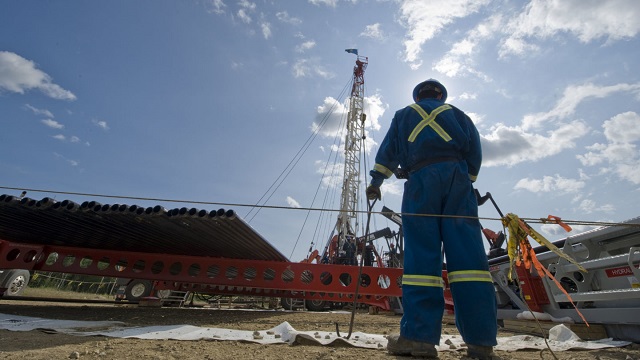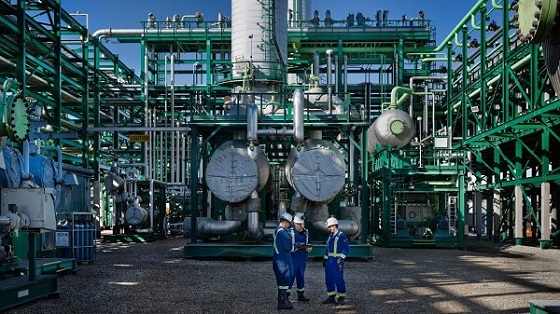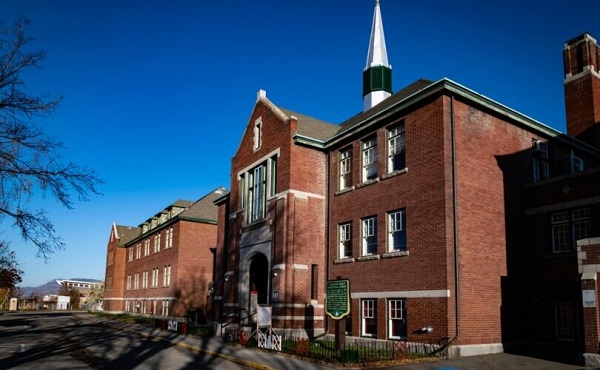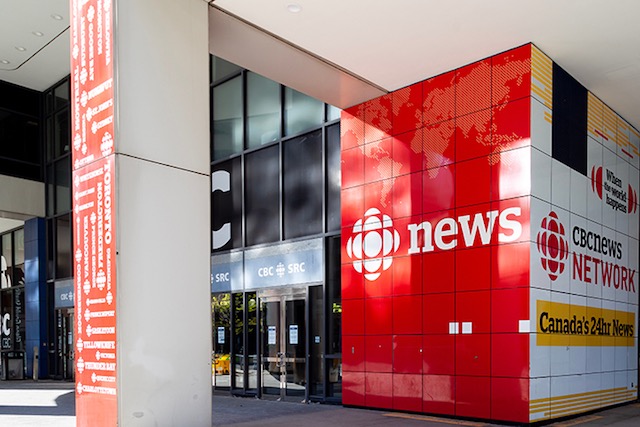Energy
New oil and gas drilling company launched by Indian Resource Council of Canada

Energy worker in Alberta. Photo courtesy Government of Alberta
From the Canadian Energy Centre
By Mario Toneguzzi and Deborah Jaremko
‘This is a great opportunity for our members to be on the ground floor of a First Nations-supported energy services company’
Indigenous ownership in Canadian oil and gas continues to grow with the launch of a new drilling company.
Along with industry heavyweights, the Indian Resource Council of Canada (IRC) is one of the founding partners of newly-formed Indigena Drilling. IRC’s aim is to provide economic benefits to its more than 155 member nations across the country.
“[This] is a great opportunity for our members to be on the ground floor of a First Nations-supported energy services company,” said Stephen Buffalo, Indian Resource Council CEO.
Gurpreet Lail, CEO of Enserva, a national trade association representing the service, supply, and manufacturing sectors of the Canadian energy industry, welcomes the new company.
“There are so many discussions happening around Indigenous economic reconciliation, but this actually is doing that instead of just talking about it,” she said.
“This kind of partnership is actually going to help all Nations, not just one.”
Indigena Drilling is an evolution of the relationship between Indigenous communities and drilling operators, says Mark Scholz, CEO of the Canadian Association of Energy Contractors (CAOEC).
“We see a lot of joint partnerships within the industry where it could be ownership or shared ownership of a rig, but I think this is a unique one coming from the lens of a company starting out with significant ownership from an Indigenous perspective would be quite new, at least in the last 10, 20 years,” he said.
Historically it has been more common for Indigenous partnerships on the service rig side of the industry, Scholz said. The main difference is that smaller service rigs conduct work on existing wells, versus drilling rigs that drill new wells.
“A service rig can actually stay very tethered to a particular area and doesn’t have to move long distances, so it’s actually quite conducive to a lot of First Nations communities that often want to stay in the community,” Scholz said.
The CAOEC forecasts approximately 6,400 wells will be drilled across western Canada this year, an increase of about 800 wells compared to 2022.
Scholz said he expects more Indigenous ownership examples like Indigena in the future, particularly in British Columbia, because of the tremendous drilling opportunities that are going to exist in supporting liquefied natural gas (LNG) exports.
“Obviously long-term, both Alberta and British Columbia have huge gas reserves. As we start talking about the energy transformation, gas is going to be incredibly important,” he said.
“I think we’re going to see more LNG takeaway capacity that’s going to have First Nations support and I do see additional opportunities for First Nations communities to have a very robust energy services sector within their communities that they’re going to be operating in.”
Lail said there are more Indigenous-owned energy services companies today than previously, but more need to come into the space.
“As an industry on the whole, I think we’ve done a really good job at moving the needle but there’s more movement that needs to happen,” she said.
“I think this is a good news story and I hope we get more of these into the future.”
Daily Caller
Blackouts Coming If America Continues With Biden-Era Green Frenzy, Trump Admin Warns


From the Daily Caller News Foundation
By Audrey Streb
The Department of Energy (DOE) released a new report Monday warning of impending blackouts if the United States continues to shutter power plants without adequately replacing retiring capacity.
DOE warned in its Monday report that blackouts could increase by 100% by 2030 if the U.S. continues to retire power plants without sufficient replacements, and that the electricity grid is not prepared to meet the demand of power-hungry data centers in the years to come without more reliable generation coming online quickly. The report specifically highlighted wind and solar, two resources pushed by Biden, as responsible for eroding grid stability and advised that dispatchable generation from sources like coal, oil, gas and nuclear are necessary to meet the anticipated U.S. power demand.
“This report affirms what we already know: The United States cannot afford to continue down the unstable and dangerous path of energy subtraction previous leaders pursued, forcing the closure of baseload power sources like coal and natural gas,” DOE Secretary Chris Wright said. “In the coming years, America’s reindustrialization and the AI race will require a significantly larger supply of around-the-clock, reliable, and uninterrupted power. President Trump’s administration is committed to advancing a strategy of energy addition, and supporting all forms of energy that are affordable, reliable, and secure. If we are going to keep the lights on, win the AI race, and keep electricity prices from skyrocketing, the United States must unleash American energy.”
Dear Readers:
As a nonprofit, we are dependent on the generosity of our readers.
Please consider making a small donation of any amount here.
Thank you!
All regional grid systems across the U.S. are expected to lose reliability in the coming years without the addition of more reliable power, according to the DOE’s report. The U.S. will need an additional 100 gigawatts of new peak hour supply by 2030, with data centers projected to require as much as half of this electricity, the report estimates; for reference, one gigawatt is enough to power up to one million homes.
President Donald Trump declared a national energy emergency on his first day back in the Oval Office and signed an executive order on April 8 ordering DOE to review and identify at-risk regions of the electrical grid, which the report released Monday does. In contrast, former President Joe Biden cracked down on conventional power sources like coal with stringent regulations while unleashing a gusher of subsidies for green energy developments.
Electricity demand is projected to hit a record high in the next several years, surging 25% by 2030, according to Energy Information Administration (EIA) data and a recent ICF International report. Demand was essentially static for the last several years, and skyrocketing U.S. power demand presents an “urgent need” for electricity resources, according to the North American Electric Reliability Corporation (NERC), a major grid watchdog.
Wright has also issued several emergency orders to major grid operators since April. New Orleans experienced blackouts just two days after Wright issued an emergency order on May 23 to the Midcontinent Independent System Operator (MISO), the regional grid operator covering the New Orleans area.
Alberta
Cross-Canada NGL corridor will stretch from B.C. to Ontario

Keyera Corp.’s natural gas liquids facilities in Fort Saskatchewan. Photo courtesy Keyera Corp.
From the Canadian Energy Centre
By Will Gibson
Keyera ‘Canadianizes’ natural gas liquids with $5.15 billion acquisition
Sarnia, Ont., which sits on the southern tip of Lake Huron and peers across the St. Clair River to Michigan, is a crucial energy hub for much of the eastern half of Canada and parts of the United States.
With more than 60 industrial facilities including refineries and chemical plants that produce everything from petroleum, resins, synthetic rubber, plastics, lubricants, paint, cosmetics and food additives in the southwestern Ontario city, Mayor Mike Bradley admits the ongoing dialogue about tariffs with Canada’s southern neighbour hits close to home.
So Bradley welcomed the announcement that Calgary-based Keyera Corp. will acquire the majority of Plains American Pipelines LLP’s Canadian natural gas liquids (NGL) business, creating a cross-Canada NGL corridor that includes a storage hub in Sarnia.
“As a border city, we’ve been on the frontline of the tariff wars, so we support anything that helps enhance Canadian sovereignty and jobs,” says the long-time mayor, who was first elected in 1988.
The assets in Sarnia are a key piece of the $5.15 billion transaction, which will connect natural gas liquids from the growing Montney and Duvernay plays in B.C. and Alberta to markets in central Canada and the eastern U.S. seaboard.
NGLs are hydrocarbons found within natural gas streams including ethane, propane and pentanes. They are important energy sources and used to produce a wide range of everyday items, from plastics and clothing to fuels.
Keyera CEO Dean Setoguchi cast the proposed acquisition as an act of repatriation.
“This transaction brings key NGL infrastructure under Canadian ownership, enhancing domestic energy capabilities and reinforcing Canada’s economic resilience by keeping value and decision-making closer to home,” Setoguchi told analysts in a June 17 call.
“Plains’ portfolio forms a fully integrated cross Canada NGL system connecting Western Canada supply to key demand centres across the Prairie provinces, Ontario and eastern U.S.,” he said.
“The system includes strategic hubs like Empress, Fort Saskatchewan and Sarnia – which provide a reliable source of Canadian NGL supply to extensive fractionation, storage, pipeline and logistics infrastructure.”
Martin King, RBN Energy’s managing director of North America Energy Market Analysis, sees Keyera’s ability to “Canadianize” its NGL infrastructure as improving the company’s growth prospects.
“It allows them to tap into the Duvernay and Montney, which are the fastest growing NGL plays in North America and gives them some key assets throughout the country,” said the Calgary-based analyst.
“The crown assets are probably the straddle plants in Empress, which help strip out the butane, ethane and other liquids for condensate. It also positions them well to serve the eastern half of the country.”
And that’s something welcomed in Sarnia.
“Having a Canadian source for natural gas would be our preference so we see Keyera’s acquisition as strengthening our region as an energy hub,” Bradley said.
“We are optimistic this will be good for our region in the long run.”
The acquisition is expected to close in the first quarter of 2026, pending regulatory approvals.
Meanwhile, the governments of Ontario and Alberta are joining forces to strengthen the economies of both regions, and the country, by advancing major infrastructure projects including pipelines, ports and rail.
A joint feasibility study is expected this year on how to move major private sector-led investments forward.
-

 COVID-1922 hours ago
COVID-1922 hours agoFDA requires new warning on mRNA COVID shots due to heart damage in young men
-

 Business20 hours ago
Business20 hours agoCarney’s new agenda faces old Canadian problems
-

 Indigenous21 hours ago
Indigenous21 hours agoInternal emails show Canadian gov’t doubted ‘mass graves’ narrative but went along with it
-

 Daily Caller17 hours ago
Daily Caller17 hours agoBlackouts Coming If America Continues With Biden-Era Green Frenzy, Trump Admin Warns
-

 Bruce Dowbiggin23 hours ago
Bruce Dowbiggin23 hours agoEau Canada! Join Us In An Inclusive New National Anthem
-

 Business2 days ago
Business2 days agoCBC six-figure salaries soar
-

 Addictions2 days ago
Addictions2 days agoMore young men want to restrict pornography: survey
-

 Business2 days ago
Business2 days agoTrump slaps Brazil with tariffs over social media censorship



